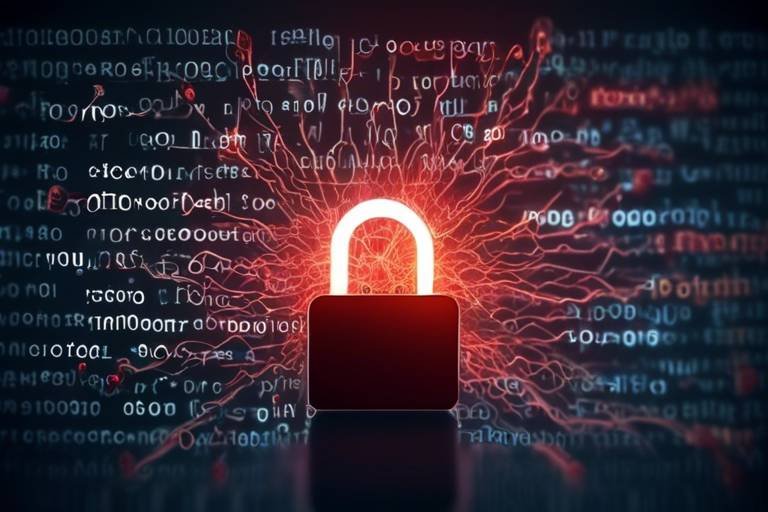Steps to Keep Your Data Safe in the IoT Era
In today’s world, where everything seems to be interconnected, the Internet of Things (IoT) has transformed the way we live and work. From smart home devices to health monitoring systems, the convenience is undeniable. However, with this convenience comes a significant responsibility—the protection of our personal data. With countless devices collecting, transmitting, and storing our information, it’s crucial to understand how to safeguard this data from potential threats. So, how can you ensure your data remains secure in this ever-evolving landscape? Let’s dive into some essential steps that individuals and organizations can take to fortify their data against the vulnerabilities present in the IoT ecosystem.
The first step to securing your data is to recognize the unique security challenges posed by IoT devices. Unlike traditional computing devices, IoT devices often lack robust security features, making them prime targets for cybercriminals. These devices can be vulnerable to various attacks, including unauthorized access, data breaches, and even the exploitation of personal information. For instance, imagine your smart thermostat being hacked, allowing an intruder to manipulate your home’s temperature settings or even gain access to your Wi-Fi network. By understanding these risks, you can better prepare yourself to implement effective security measures.
One of the most straightforward yet effective ways to protect your IoT devices is by creating strong, unique passwords. Many people fall into the trap of using simple passwords that are easy to remember but also easy for hackers to guess. Think of your password as the front door to your digital home; if it’s weak, you’re inviting trouble. To enhance your security, consider the following tips:
- Use a mix of uppercase and lowercase letters, numbers, and special characters.
- Avoid using easily accessible information, such as birthdays or names.
- Make your passwords at least 12 characters long.
By following these guidelines, you significantly reduce the risk of unauthorized access to your devices.
Managing multiple passwords can be overwhelming, especially with the sheer number of IoT devices we use daily. This is where password managers come into play. These tools securely store and generate complex passwords, making it easier to maintain strong security across all your devices. Imagine having a digital vault that not only remembers your passwords but also creates new, secure ones for you—sounds like a dream, right? With a password manager, you can focus on what matters without constantly worrying about forgetting your passwords.
When selecting a password manager, consider key features that enhance your data security:
- Encryption Standards: Ensure the manager uses strong encryption to protect your data.
- User Interface: Look for a user-friendly interface that makes navigation easy.
- Compatibility: Ensure it works seamlessly across all your devices.
By taking the time to choose the right password manager, you can ensure that your sensitive information is kept safe and sound.
Changing your passwords regularly is another crucial practice that can significantly reduce the risk of unauthorized access. Just like changing the locks on your front door periodically, updating your passwords can keep intruders at bay. Aim to change your passwords every three to six months, and don’t forget to update them immediately if you suspect any suspicious activity. This simple act can be a game-changer in your data protection strategy.
Two-factor authentication (2FA) is a powerful tool that adds an extra layer of security to your IoT devices. With 2FA, even if someone manages to obtain your password, they would still need a second form of verification—typically a code sent to your phone or email. This additional step can deter potential threats and provide you with peace of mind. Think of it as having a security guard at the entrance of your digital home, ready to stop any unwanted guests.
Another vital aspect of IoT security is keeping your software and firmware updated. Manufacturers often release updates to patch vulnerabilities and protect against emerging security threats. Failing to update your devices can leave them exposed to attacks. It’s similar to ignoring a warning sign about a potential leak in your roof; if you don’t take action, the damage could be catastrophic.
To simplify the process of maintaining device security, consider enabling automatic updates whenever possible. This feature ensures that your devices always have the latest protections in place without requiring constant manual intervention. It’s like having a personal assistant who takes care of your security needs, allowing you to focus on more important tasks.
Finally, keep an eye on your IoT device activity. Regularly monitoring for unusual behavior can help you identify potential security breaches early on. For instance, if your smart camera suddenly starts recording at odd hours, it might be time to investigate. By staying vigilant, you can mitigate risks effectively and protect your valuable data.
- What is IoT security? IoT security refers to the measures taken to protect connected devices and networks from cyber threats.
- Why are strong passwords important? Strong passwords prevent unauthorized access to your devices and sensitive information.
- What is two-factor authentication? Two-factor authentication is a security process that requires two forms of verification before granting access.
- How often should I update my passwords? It’s recommended to update your passwords every three to six months.
- Can I automate software updates? Yes, many devices offer the option to enable automatic updates for security patches.

Understanding IoT Security Risks
The Internet of Things (IoT) has revolutionized the way we interact with technology, but it also brings a host of security risks that we must confront. As our devices become more interconnected, the potential vulnerabilities multiply, creating a landscape where our personal data is at constant risk. Imagine your smart refrigerator being hacked; it might sound far-fetched, but with IoT, such scenarios are increasingly plausible. This interconnectedness means that a breach in one device can lead to a domino effect, compromising your entire network.
One of the primary challenges in IoT security is the sheer number of devices. According to recent estimates, there are billions of IoT devices in use globally, each one potentially serving as a gateway for cybercriminals. These devices often operate with minimal security measures, making them easy targets. For instance, many IoT devices come with default passwords that users neglect to change, leaving them vulnerable to attacks. This is akin to leaving your front door unlocked; it’s an open invitation for intruders.
Moreover, the data transmitted between these devices can be intercepted if not adequately secured. This includes sensitive information such as personal health data from wearables or financial details from smart home devices. When you think about it, every time you interact with your IoT devices, you are sharing a piece of your digital footprint. Without proper safeguards, this data can be exploited by malicious actors, leading to identity theft, financial loss, or worse.
Another significant risk factor is the lack of standardized security protocols across different devices and manufacturers. Each company may have its own security measures, which can lead to inconsistencies and gaps in protection. When devices from various manufacturers communicate, these differences can create vulnerabilities. For example, if one device is compromised, it can potentially provide access to others that do not have robust security measures in place. This situation necessitates a comprehensive understanding of the security features of each device you own.
In summary, understanding IoT security risks is crucial for anyone who uses connected devices. By being aware of the vulnerabilities and the potential consequences of a security breach, you can take proactive steps to safeguard your data. Here are some key risks to keep in mind:
- Weak Passwords: Default passwords and weak user-created passwords make devices easy targets.
- Data Interception: Unsecured data transfers can lead to sensitive information being intercepted.
- Lack of Standards: Inconsistent security measures across devices can create vulnerabilities.
By acknowledging these risks, you can begin to implement strategies that will help protect your data in this increasingly connected world.
Q1: What is IoT?
A1: IoT stands for the Internet of Things, which refers to the network of interconnected devices that communicate and exchange data with each other.
Q2: Why are IoT devices vulnerable?
A2: Many IoT devices have weak security measures, such as default passwords, and often lack regular updates, making them easy targets for cybercriminals.
Q3: How can I secure my IoT devices?
A3: You can secure your IoT devices by changing default passwords, enabling two-factor authentication, and keeping your software updated.

Implementing Strong Passwords
In today's digital landscape, where every device is interconnected, the importance of implementing strong passwords cannot be overstated. Think of your password as the key to your digital home; if it’s weak, it’s like leaving your front door wide open for anyone to waltz in. Many people underestimate the power of a robust password, believing that a simple word or a birthday is sufficient. However, with the rise of sophisticated hacking techniques, a strong password is your first line of defense against unauthorized access and potential data breaches.
So, what makes a password strong? A strong password typically includes a mix of uppercase and lowercase letters, numbers, and special characters. It should be at least 12 characters long and avoid easily guessable information like your name or common words. For instance, instead of using "Password123," consider a phrase like "I<3MyC@t&Sunsets!" which combines various elements and is much harder to crack. This complexity adds layers of difficulty for malicious actors trying to gain access to your accounts.
One of the challenges many face is remembering these complex passwords for multiple devices. This is where password managers come into play. They can generate and store strong passwords securely, allowing you to focus on other aspects of your digital security without the hassle of memorizing each password. With a password manager, you can create unique passwords for each of your IoT devices, ensuring that if one gets compromised, the others remain secure.
Using a password manager can significantly enhance your security posture. These tools not only store your passwords securely but can also generate complex passwords that adhere to best practices. Imagine having a personal assistant that remembers every password for you—this is essentially what a password manager does. Some popular options include LastPass, Dashlane, and 1Password, each offering unique features that cater to different user needs.
When selecting a password manager, it’s essential to consider several key features:
- Encryption Standards: Look for managers that use strong encryption methods to protect your data.
- User Interface: A user-friendly interface can make it easier to manage your passwords effectively.
- Device Compatibility: Ensure the manager works across all your devices, whether it’s a smartphone, tablet, or computer.
By focusing on these features, you can choose a password manager that not only meets your needs but also enhances your overall data security.
Another critical aspect of password management is the practice of regularly updating passwords. It’s like changing the locks on your doors periodically; it can prevent unauthorized access even if your previous password was compromised. Experts recommend changing your passwords every three to six months, especially for sensitive accounts. This practice can significantly reduce the risk of unauthorized access to your IoT devices and other accounts.
While strong passwords are vital, they are even more effective when combined with two-factor authentication (2FA). This additional layer of security requires you to provide two forms of identification before gaining access to your accounts. For example, after entering your password, you might receive a code on your phone that you must enter to complete the login process. This means that even if someone manages to steal your password, they would still need that second factor to access your account, making it significantly harder for them to succeed.

Using Password Managers
In today's digital age, managing passwords can feel like trying to juggle flaming torches while riding a unicycle—it's tricky and one slip can lead to disaster. This is where password managers come into play, acting as your safety net in the chaotic circus of online security. A password manager is a tool that securely stores and manages your passwords, making it easier to maintain strong, unique passwords for each of your IoT devices and online accounts. Imagine having a personal vault that not only keeps your secrets safe but also generates complex passwords for you. Sounds like a dream, right?
One of the biggest advantages of using a password manager is that it eliminates the need to remember every single password. Instead, you only need to remember one master password to access the vault. This approach significantly reduces the temptation to use weak passwords or reuse passwords across different platforms, both of which are common pitfalls that can lead to data breaches. With a password manager, you can create strong, random passwords that are nearly impossible for hackers to crack.
Many password managers also offer features that enhance your overall security experience. For example, they can alert you if any of your stored accounts have been compromised in a data breach. This proactive approach allows you to change your passwords quickly and minimize the risk of unauthorized access. Additionally, some password managers provide a built-in password strength checker, helping you to evaluate the strength of your existing passwords and prompting you to make necessary changes.
However, not all password managers are created equal. When choosing one, it's important to look for key features that align with your security needs. Here are some critical aspects to consider:
- Encryption Standards: Ensure that the password manager uses strong encryption to protect your data. Look for AES-256 bit encryption, which is currently one of the most secure methods.
- User Interface: A user-friendly interface can make a world of difference. You want a password manager that allows you to navigate easily and quickly access your passwords.
- Compatibility: Check whether the password manager is compatible with all your devices and browsers. It should seamlessly integrate into your daily online activities.
By incorporating a password manager into your digital life, you can significantly enhance your data security. Not only do they simplify the process of managing numerous passwords, but they also provide a robust layer of protection against potential threats. In a world where cyber threats are constantly evolving, having a reliable password manager is like having a trusted bodyguard for your online identity—always watching, always protecting.

Choosing the Right Password Manager
When it comes to protecting your data in the Internet of Things (IoT) era, selecting the right password manager can feel like finding a needle in a haystack. With so many options available, how do you know which one is the best fit for your needs? Choosing a password manager is not just about convenience; it’s about ensuring that your sensitive information is locked away tighter than a vault. Here are some essential features to consider that can help you make an informed decision.
First and foremost, encryption standards are crucial. A password manager should use advanced encryption methods, such as AES-256, to ensure that your data is scrambled and unreadable to anyone who doesn’t have the decryption key. Think of encryption as a secret language that only you and your password manager understand. If a hacker manages to get their hands on your data, they should see nothing but gibberish.
Next, consider the user interface. A password manager should be user-friendly, making it easy for you to navigate through your vault of passwords without feeling like you’re deciphering an ancient manuscript. A clean, intuitive design can make all the difference, especially when you’re in a rush and need to access a password quickly. Remember, if it’s too complicated, you might be tempted to skip using it altogether, which defeats the purpose.
Another essential factor is compatibility. Your password manager should seamlessly integrate with various devices and browsers. Whether you’re on your smartphone, tablet, or desktop, having access to your passwords wherever you go is vital. Imagine being at a coffee shop and needing to log into your bank account; if your password manager doesn’t work on your device, you could be left scrambling.
Lastly, take a look at the customer support options available. If you run into issues or have questions, you’ll want to know that help is just a click away. Look for password managers that offer comprehensive support through various channels, such as live chat, email, and even phone support. This can save you a lot of headaches down the line.
In summary, when choosing a password manager, pay attention to encryption standards, user interface, compatibility, and customer support. The right password manager acts as your personal security guard in the digital world, ensuring that your sensitive information remains safe from prying eyes. After all, in this connected world, your data deserves the best protection available.
- What is a password manager? A password manager is a tool that helps you store, generate, and manage your passwords securely.
- Are password managers safe to use? Yes, as long as you choose one that employs strong encryption and has a good reputation.
- Can I use a password manager on multiple devices? Most password managers are designed to work across multiple devices and browsers, ensuring you have access wherever you need it.
- What happens if I forget my master password? Most password managers have recovery options, but it’s crucial to choose one that offers a secure way to regain access.

Regularly Updating Passwords
In today's fast-paced digital landscape, regularly updating your passwords is not just a good practice; it's a necessity. Think of your passwords as the locks on your front door. If you never change the locks, over time, they become less secure, and anyone who has a key can waltz right in. Similarly, as technology evolves and cyber threats become more sophisticated, your old passwords may no longer be sufficient to keep your data safe.
When you consider the sheer number of IoT devices we use daily—from smart home assistants to fitness trackers—it's crucial to understand that each device represents a potential entry point for hackers. Regular updates can significantly reduce the risk of unauthorized access. So, how often should you change your passwords? Experts recommend at least every three to six months, but if you've had a security scare or suspect that your password may have been compromised, it's time to change it immediately.
Moreover, when updating your passwords, ensure that you create unique and complex combinations that include a mix of letters, numbers, and symbols. Avoid using easily guessed information, such as birthdays or pet names. A strong password is like a fortress; the more complex it is, the harder it is for intruders to penetrate. To help you remember these complex passwords, consider using a password manager, which can securely store and generate them for you.
In addition to changing your passwords regularly, it's also essential to keep track of where you use them. You might have a different password for each device or service, which can be overwhelming. This is where a password manager shines, allowing you to maintain strong security without the hassle of memorizing every single password. Just remember, the key to effective security is not just in having strong passwords but also in keeping them fresh and updated.
Finally, if you share access to any devices or accounts, be sure to update your passwords whenever someone no longer needs access. This simple step can prevent potential breaches and keep your data safe. In a world where cyber threats are constantly evolving, being proactive about password management can make all the difference in safeguarding your information.
- How often should I update my passwords? It's recommended to change your passwords every three to six months or immediately if you suspect a breach.
- What makes a strong password? A strong password should include a mix of upper and lower case letters, numbers, and special characters, and should be at least 12 characters long.
- Can a password manager help? Yes, password managers can securely store and generate complex passwords, making it easier to manage multiple accounts without compromising security.
- What should I do if I forget my password? Most services offer a password recovery option. Use this feature to reset your password securely.

Enabling Two-Factor Authentication
In today's digital landscape, where threats lurk around every corner, enabling two-factor authentication (2FA) is like putting a sturdy lock on your front door. You wouldn’t leave your home unprotected, so why risk your personal data? Two-factor authentication adds an extra layer of security that goes beyond just a username and password. It requires not only something you know (your password) but also something you have (like a smartphone or a security token). This means that even if a hacker manages to steal your password, they would still need that second factor to gain access to your accounts.
Imagine you’re in a crowded café, sipping your favorite coffee while working on your laptop. You log into your IoT device, and suddenly, you receive a notification on your phone asking for a verification code. This is 2FA in action! It’s a simple yet effective way to ensure that you are the only one accessing your sensitive data. By requiring a second piece of information, you significantly reduce the chances of unauthorized access, making it a crucial step in your cybersecurity strategy.
Many IoT devices and online services now offer 2FA as a standard feature. Here’s how it typically works:
- After entering your password, you receive a code via SMS, email, or an authentication app.
- You enter that code to gain access to your account.
- If you don’t have the second factor, even with the correct password, you won’t be able to log in.
One of the most popular methods of 2FA is through authentication apps like Google Authenticator or Authy. These apps generate time-sensitive codes that are much more secure than SMS codes, which can be intercepted. By using an authentication app, you’re not just adding a layer of security; you’re fortifying your defenses against cyber threats.
However, it’s important to remember that while 2FA is a powerful tool, it’s not foolproof. It’s essential to combine it with other security measures, such as strong passwords and regular software updates. Think of 2FA as part of a multi-layered security system—each layer enhances your overall protection. The more layers you have, the harder it is for cybercriminals to breach your defenses.
In conclusion, enabling two-factor authentication is a vital step in securing your IoT devices and online accounts. It’s a simple action that can lead to significant peace of mind, knowing that your data is better protected against unauthorized access. So, the next time you set up a new device or service, don’t skip this crucial step—your future self will thank you!
Q: What is two-factor authentication?
A: Two-factor authentication (2FA) is a security process that requires two different forms of identification before granting access to an account, adding an extra layer of protection.
Q: How does two-factor authentication work?
A: After entering your password, 2FA requires a second form of identification, such as a code sent to your phone or generated by an authentication app.
Q: Is two-factor authentication necessary?
A: Yes, 2FA significantly reduces the risk of unauthorized access, especially for sensitive accounts or devices connected to the Internet of Things (IoT).
Q: Can I use two-factor authentication on all my devices?
A: Most modern IoT devices and online services support 2FA, but always check the specific settings and options available for each device or service.

Keeping Software Updated
In today’s fast-paced digital landscape, keeping your software updated is not just a good practice; it’s a necessity. Each IoT device you own—be it a smart thermostat, security camera, or wearable fitness tracker—operates on software that is constantly evolving. Manufacturers frequently release updates that patch vulnerabilities, enhance functionality, and improve user experience. Ignoring these updates can leave your devices exposed to potential threats, akin to leaving your front door wide open in a neighborhood known for burglaries.
One of the primary reasons to keep your software updated is to protect against emerging security threats. Cybercriminals are always on the lookout for weaknesses in outdated software. When a new vulnerability is discovered, manufacturers rush to release updates to fix these issues. If you’re not updating your devices, you’re essentially giving hackers a golden opportunity to exploit those vulnerabilities. Just like a knight needs armor to fend off dragons, your devices need the latest software updates to defend against cyber threats.
Moreover, updates often come with new features and improvements that can enhance your experience. Imagine buying a new smartphone only to find out that the latest software allows for faster processing speeds and better battery life. By neglecting updates, you’re not only risking your security but also missing out on the full potential of your devices. It’s like buying a sports car and never taking it out of the garage—you’re not experiencing the thrill of the ride!
To make the update process easier, many devices now allow for automatic updates. This feature ensures that your software is updated without you having to lift a finger. However, it’s crucial to check that this setting is enabled on all your devices. If you’re unsure how to do this, consult the user manual or the manufacturer’s website. Keeping your devices on autopilot can save you time and provide peace of mind, knowing that your security is being taken care of.
For those who prefer a hands-on approach, it’s advisable to set a regular schedule to check for updates. A simple reminder on your calendar can prompt you to review your devices monthly or bi-monthly. During this check, ensure that all devices are running the latest software versions. If you encounter any issues, don’t hesitate to seek help from customer support or online forums. Keeping your software updated is a small investment of time that can yield substantial dividends in security and performance.
Lastly, monitoring your device activity can give you insights into whether your updates are effective. If you notice unusual behavior or performance issues, it may be time to investigate further. This proactive approach can help you catch potential security breaches early, allowing you to take corrective action before it’s too late. Remember, in the world of IoT, an ounce of prevention is worth a pound of cure!
- Why is it important to keep IoT devices updated? Keeping your devices updated protects against vulnerabilities and enhances functionality.
- How can I enable automatic updates? Check your device settings or user manual for instructions on enabling automatic updates.
- What should I do if I notice unusual device behavior? Investigate the issue immediately, as it may indicate a security breach.

Automating Updates
In the fast-paced world of the Internet of Things (IoT), keeping your devices secure can feel like a daunting task. However, one of the simplest yet most effective ways to enhance your data security is by . Imagine your IoT devices as living organisms; just like they need regular check-ups to stay healthy, they require updates to fend off vulnerabilities. By automating these updates, you ensure that your devices are always equipped with the latest security patches and features, significantly reducing the risk of cyber threats.
Many IoT devices come with the option to enable automatic updates, which means that whenever a new software version or security patch is released, your devices will download and install it without you having to lift a finger. This is akin to having a personal assistant who takes care of all your chores while you focus on more important matters. However, it’s essential to remember that not all devices support this feature, and some may require you to toggle settings manually. Therefore, it’s crucial to check the specifications of each device and enable automatic updates wherever possible.
But why stop there? Keeping your devices updated is only part of the equation. You should also be aware of the nature of these updates. Some updates may improve functionality, while others specifically address security vulnerabilities. Understanding the difference can help you appreciate the importance of these updates. To illustrate this, consider the following table:
| Type of Update | Description | Importance |
|---|---|---|
| Security Update | Patches vulnerabilities that could be exploited by hackers. | Critical |
| Feature Update | Adds new functionalities or improves existing features. | Useful |
| Performance Update | Enhances the overall performance of the device. | Beneficial |
Moreover, automating updates not only saves you time but also helps you maintain a consistent security posture across all your devices. Think about it: if you have multiple IoT devices scattered throughout your home or office, manually updating each one can be a tedious and error-prone task. By automating the process, you eliminate the risk of forgetting to update a device, which could leave a gaping hole in your security defenses.
In conclusion, automating updates is a crucial step in safeguarding your data in the IoT era. It’s a proactive measure that ensures your devices are always protected against the latest threats, allowing you to enjoy the conveniences of smart technology without the nagging worry of security breaches. So, take a moment to explore the settings of your IoT devices, enable those automatic updates, and let technology work for you!
- What devices can I automate updates for? Most smart devices, including smart thermostats, security cameras, and smart speakers, typically offer an option for automatic updates. Check the user manual or device settings for more information.
- Will automating updates slow down my device? Generally, automatic updates are designed to enhance performance and security. However, if an update is large, it may temporarily slow down your device during the installation process.
- Can I turn off automatic updates? Yes, you can usually disable automatic updates in the device settings. However, it’s recommended to keep them enabled to ensure your devices remain secure.

Monitoring Device Activity
In an era where the Internet of Things (IoT) is seamlessly integrating into our daily lives, has become a vital component of safeguarding our personal and organizational data. Just like a vigilant security guard keeping an eye on the premises, monitoring your IoT devices helps you detect suspicious behavior before it escalates into a full-blown security breach. Imagine your smart home as a bustling city; if you don't keep an eye on the traffic patterns, you might miss a major incident waiting to happen.
So, how can you effectively monitor your IoT devices? First off, it's essential to understand the typical activity patterns of your devices. This means knowing what "normal" looks like. For instance, if your smart thermostat usually adjusts the temperature every few hours, a sudden spike in activity could indicate a potential hack. By setting up alerts for unusual behavior, you can act quickly to mitigate risks. Think of it as having a smoke detector; it alerts you before a fire consumes your home.
Moreover, many IoT devices come with built-in monitoring features that track their performance and activity. Take advantage of these features! They can provide valuable insights into how your devices are functioning and whether they are communicating securely. You might be surprised to learn that some devices log data on their usage, which can help you identify patterns and anomalies. For example, if your smart security camera is suddenly accessing data at odd hours, it could be worth investigating.
Additionally, consider investing in third-party monitoring solutions that specialize in IoT security. These tools can offer a more comprehensive overview of your device network and can alert you to potential threats that you might miss. They act like a high-tech security system, scanning for vulnerabilities and unusual activities across all your connected devices. While it may seem like an extra expense, think of it as an investment in your peace of mind.
Finally, regular audits of your device activity can help you stay ahead of potential threats. Schedule periodic reviews of your device logs and settings to ensure everything is functioning as it should. This proactive approach can save you from headaches down the line. Just like you wouldn't ignore a check engine light in your car, don't ignore the signs of unusual activity in your IoT devices.
- What should I look for when monitoring my IoT devices? Focus on unusual access patterns, unexpected data usage, and any alerts from your devices.
- How often should I check my device activity? Regular checks are recommended, ideally at least once a month, but more frequent monitoring is better.
- Can I automate the monitoring process? Yes, many IoT devices and third-party tools offer automated monitoring features to alert you of any suspicious activity.
- What should I do if I notice unusual activity? Immediately investigate the source, change your passwords, and consider resetting the device to factory settings if necessary.
Frequently Asked Questions
- What are the main security risks associated with IoT devices?
The main security risks include vulnerabilities in device software, weak passwords, and insecure networks. These can lead to unauthorized access, data breaches, and privacy violations. It's crucial to be aware of these risks to take proactive steps in safeguarding your data.
- How can I create strong passwords for my IoT devices?
To create strong passwords, use a mix of upper and lower case letters, numbers, and special characters. Aim for at least 12 characters and avoid using easily guessable information like birthdays or names. A password manager can help you generate and store complex passwords securely.
- What is two-factor authentication and why is it important?
Two-factor authentication (2FA) adds an extra layer of security by requiring not just a password but also a second form of verification, such as a text message code or an authentication app. This makes it significantly harder for unauthorized users to gain access to your devices.
- How often should I update my IoT device passwords?
It's recommended to change your passwords every 3 to 6 months. Regular updates can help protect against unauthorized access, especially if there’s been a reported breach in the device’s software or services.
- Why is it crucial to keep my IoT device software updated?
Keeping your software updated is essential because updates often include security patches that fix vulnerabilities. By not updating, you leave your devices exposed to potential threats and attacks that could compromise your data.
- Can I automate software updates for my IoT devices?
Yes, many IoT devices allow you to enable automatic updates. This ensures that you always have the latest security features and protections without having to manually check for updates regularly.
- How can I monitor the activity of my IoT devices?
You can monitor device activity through the device's app or web interface, which often provides logs of usage and alerts for unusual behavior. Regularly checking these logs can help you spot potential security breaches early.



















